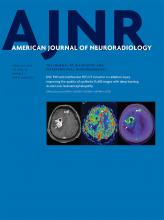Index by author
Brinjikji, W.
- SpineYou have accessSingle-Needle Lateral Sacroplasty TechniqueP.J. Nicholson, C.A. Hilditch, W. Brinjikji, A.C.O. Tsang and R. SmithAmerican Journal of Neuroradiology February 2019, 40 (2) 382-385; DOI: https://doi.org/10.3174/ajnr.A5884
Caldarelli, M.
- PediatricsYou have accessBrain DSC MR Perfusion in Children: A Clinical Feasibility Study Using Different Technical Standards of Contrast AdministrationS. Gaudino, M. Martucci, A. Botto, E. Ruberto, E. Leone, A. Infante, A. Ramaglia, M. Caldarelli, P. Frassanito, F.M. Triulzi and C. ColosimoAmerican Journal of Neuroradiology February 2019, 40 (2) 359-365; DOI: https://doi.org/10.3174/ajnr.A5954
Castellino, R.C.
- PediatricsYou have accessHigh-Grade Gliomas in Children with Neurofibromatosis Type 1: Literature Review and Illustrative CasesC.D. Spyris, R.C. Castellino, M.J. Schniederjan and N. KadomAmerican Journal of Neuroradiology February 2019, 40 (2) 366-369; DOI: https://doi.org/10.3174/ajnr.A5888
Chen, L.
- EDITOR'S CHOICEHead & NeckOpen AccessTreatment Response Prediction of Nasopharyngeal Carcinoma Based on Histogram Analysis of Diffusional Kurtosis ImagingN. Tu, Y. Zhong, X. Wang, F. Xing, L. Chen and G. WuAmerican Journal of Neuroradiology February 2019, 40 (2) 326-333; DOI: https://doi.org/10.3174/ajnr.A5925
Thirty-six patients with an initial diagnosis of locoregionally advanced nasopharyngeal carcinoma and diffusional kurtosis imaging acquisitions before and after neoadjuvant chemotherapy were enrolled. Patients were divided into respond-versus-nonrespond groups after neoadjuvant chemotherapy and residual-versus-nonresidual groups after radiation therapy. Receiver operating characteristic analysis indicated that setting pre-D50th = 0.875 x 10-3 mm2/s as the cutoff value could result in optimal diagnostic performance for neoadjuvant chemotherapy response prediction (area under the curve = 0.814, sensitivity = 0.70, specificity = 0.92), while the post-K90th = 1.035 (area under the curve = 0.829, sensitivity = 0.78, specificity = 0.72) was optimal for radiation therapy response prediction. Histogram analysis of diffusional kurtosis imaging may potentially predict the neoadjuvant chemotherapy and short-term radiation therapy response in locoregionally advanced nasopharyngeal carcinoma.
Chen, Q.
- EDITOR'S CHOICEAdult BrainOpen AccessUtility of Dynamic Susceptibility Contrast Perfusion-Weighted MR Imaging and 11C-Methionine PET/CT for Differentiation of Tumor Recurrence from Radiation Injury in Patients with High-Grade GliomasZ. Qiao, X. Zhao, K. Wang, Y. Zhang, D. Fan, T. Yu, H. Shen, Q. Chen and L. AiAmerican Journal of Neuroradiology February 2019, 40 (2) 253-259; DOI: https://doi.org/10.3174/ajnr.A5952
Forty-two patients with high-grade gliomas were enrolled in this study. The final diagnosis was determined by histopathologic analysis or clinical follow-up. PWI and PET parameters were recorded and compared between patients with recurrence and those with radiation injury using Student t tests. Receiver operating characteristic and logistic regression analyses were used to determine the diagnostic performance of each parameter. The final diagnosis was recurrence in 33 patients and radiation injury in 9. PET/CT showed a patient-based sensitivity and specificity of 0.909 and 0.556, respectively, while PWI showed values of 0.667 and 0.778, respectively. The maximum standardized uptake value, mean standardized uptake value, tumor-to-background maximum standardized uptake value, and mean relative CBV were significantly higher for patients with recurrence than for patients with radiation injury. All these parameters showed a significant discriminative power in receiver operating characteristic analysis. Both 11C-methionine PET/CT and PWI are equally accurate in the differentiation of recurrence from radiation injury in patients with high-grade gliomas, and a combination of the 2 modalities could result in increased diagnostic accuracy.
Chen, Y.
- Head & NeckOpen AccessContrast-Enhanced 3D-FLAIR Imaging of the Optic Nerve and Optic Nerve Head: Novel Neuroimaging Findings of Idiopathic Intracranial HypertensionE. Golden, R. Krivochenitser, N. Mathews, C. Longhurst, Y. Chen, J.-P.J. Yu and T.A. KennedyAmerican Journal of Neuroradiology February 2019, 40 (2) 334-339; DOI: https://doi.org/10.3174/ajnr.A5937
Chen, Y.-F.
- Adult BrainOpen AccessStandardized MR Perfusion Scoring System for Evaluation of Sequential Perfusion Changes and Surgical Outcome of Moyamoya DiseaseY.-H. Lin, M.-F. Kuo, C.-J. Lu, C.-W. Lee, S.-H. Yang, Y.-C. Huang, H.-M. Liu and Y.-F. ChenAmerican Journal of Neuroradiology February 2019, 40 (2) 260-266; DOI: https://doi.org/10.3174/ajnr.A5945
Cheng, M.
- Review ArticleOpen AccessA Review of Magnetic Particle Imaging and Perspectives on NeuroimagingL.C. Wu, Y. Zhang, G. Steinberg, H. Qu, S. Huang, M. Cheng, T. Bliss, F. Du, J. Rao, G. Song, L. Pisani, T. Doyle, S. Conolly, K. Krishnan, G. Grant and M. WintermarkAmerican Journal of Neuroradiology February 2019, 40 (2) 206-212; DOI: https://doi.org/10.3174/ajnr.A5896
Chougar, L.
- EDITOR'S CHOICEAdult BrainOpen AccessImproving the Quality of Synthetic FLAIR Images with Deep Learning Using a Conditional Generative Adversarial Network for Pixel-by-Pixel Image TranslationA. Hagiwara, Y. Otsuka, M. Hori, Y. Tachibana, K. Yokoyama, S. Fujita, C. Andica, K. Kamagata, R. Irie, S. Koshino, T. Maekawa, L. Chougar, A. Wada, M.Y. Takemura, N. Hattori and S. AokiAmerican Journal of Neuroradiology February 2019, 40 (2) 224-230; DOI: https://doi.org/10.3174/ajnr.A5927
Forty patients with MS were prospectively included and scanned (3T) to acquire synthetic MR imaging and conventional FLAIR images. Synthetic FLAIR images were created with the SyMRI software. Acquired data were divided into 30 training and 10 test datasets. A conditional generative adversarial network was trained to generate improved FLAIR images from raw synthetic MR imaging data using conventional FLAIR images as targets. The peak signal-to-noise ratio, normalized root mean square error, and the Dice index of MS lesion maps were calculated for synthetic and deep learning FLAIR images against conventional FLAIR images, respectively. Lesion conspicuity and the existence of artifacts were visually assessed. The peak signal-to-noise ratio and normalized root mean square error were significantly higher and lower, respectively, in generated-versus-synthetic FLAIR images in aggregate intracranial tissues and all tissue segments. The Dice index of lesion maps and visual lesion conspicuity were comparable between generated and synthetic FLAIR images. Using deep learning, the authors conclude that they improved the synthetic FLAIR image quality by generating FLAIR images that have contrast closer to that of conventional FLAIR images and fewer granular and swelling artifacts, while preserving the lesion contrast.
Clark, M.S.
- SpineYou have accessRenal Contrast on CT Myelography: Diagnostic Value in Patients with Spontaneous Intracranial HypotensionK.A. Kinsman, J.T. Verdoorn, P.H. Luetmer, M.S. Clark and F.E. DiehnAmerican Journal of Neuroradiology February 2019, 40 (2) 376-381; DOI: https://doi.org/10.3174/ajnr.A5934








